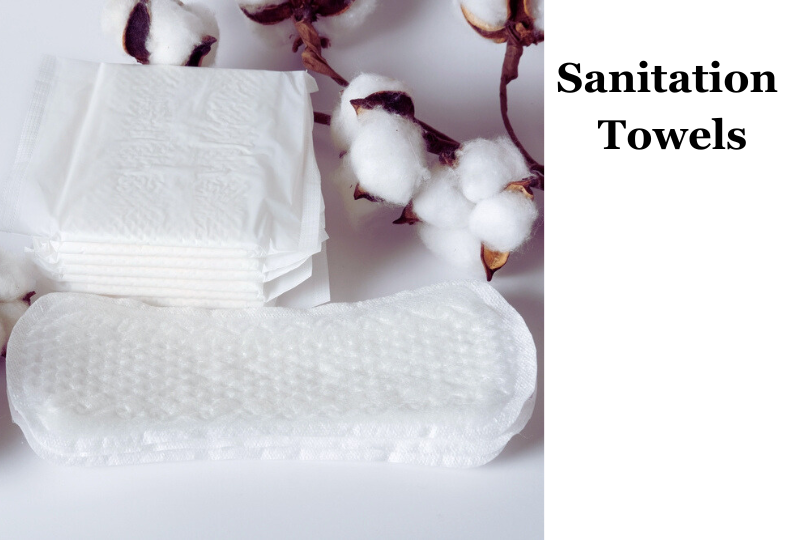
Sanitation Towels: An All-Inclusive Handbook of Female Hygiene
It is impossible to exaggerate the significance of good feminine hygiene for women’s health and wellbeing. During menstruation, Sanitation Towels—also referred to as sanitary pads or napkins—are essential for preserving comfort and hygiene. We will examine the history, varieties, use, and environmental effects of sanitation towels in this extensive guide, providing insight into this crucial area of feminine hygiene.
First of all, Sanitation Towels: A Guide to Feminine Hygiene
Sanitation towels have become an essential tool for managing menstrual hygiene, and maintaining feminine hygiene is a crucial part of women’s health. In addition to offering protection, these pads are made to be comfortable and convenient for women going through their menstrual cycle.
Sanitation Towels: What Are They?
Sanitation towels are little, throwaway cloths that you can use to wash your hands without using water or soap. They are composed of a unique material that efficiently cleanses your skin of debris and germs. You can use them with confidence because they are biodegradable, available in a variety of sizes and shapes. It is useful for cleaning floors, tables, countertops, and other surfaces. Sanitary towels, sometimes referred to as sanitary pads, are used by women when they are menstruating.
The Development of Sanitation Towels
Historical Angles
Menstrual hygiene has been around for millennia, and historical records indicate the different ways that women have managed their periods over the years. The development of sanitary towels, from simple materials like wool and grass to the introduction of disposable pads, is a reflection of both societal advancement and a developing knowledge of women’s health.
Contemporary Innovations
Products for feminine hygiene saw tremendous developments in the 20th century. Menstrual care was transformed by disposable sanitary pads composed of absorbent materials, which provided increased comfort and convenience. Since then, the market has experienced constant innovation as wings, incredibly thin designs, and organic materials have been introduced.
Sanitation Towel Types
Ordinary Sanitary Pads
These sanitary towels are the most popular and extensively used ones. To accommodate varying flow volumes, they are available in a range of diameters and absorbencies. Conventional pads fit over undergarments and provide dependable all-day protection.
Ultra-Thin Pads
Ultra-thin pads are made for people who want a discrete, lightweight solution that offers consistent absorption without adding extra bulk. For people with light to moderate flow, they are perfect.
Wing-equipped Maxi Pads
Winged pads prevent side leaks by encircling the underwear to offer extra protection. The heavier flow types are especially fond of this style.
Eco-friendly and Organic Choices
Organic and environmentally friendly sanitary towels are becoming more and more popular as a response to environmental concerns. These pads, which are made of biodegradable materials, seek to reduce their negative effects on the environment while providing a natural and safe substitute.
Use and Hygiene Procedures Correctly
Altering Frequently
It is essential to routinely change sanitation towels in order to maintain maximum hygiene. Although the frequency may differ depending on each person’s flow, changing pads every 4-6 hours is a common recommendation.
Selecting the Appropriate Absorbency
To effectively protect, the right absorbency level must be chosen. A less absorbent pad could be needed for lighter flows, whilst a higher absorbency level is required for heavy flows.
Keeping Things Tidy
It’s critical to dispose of used pads properly to preserve cleanliness. Used pads should be discreetly and hygienically disposed of by wrapping them in the included packaging or in special disposal bags to help keep odors contained.
Portfolio Diet Can Help Lower Cholesterol, Reduce Heart Disease Risk
The Effects of Sanitation Towels on the Environment
The Problem with Disposal
Because traditional sanitary pads are not biodegradable, there have been concerns about how they affect the environment. Pollution in the environment and landfill waste can be caused by improper disposal.
Eco-friendly Options
Eco-friendly solutions have emerged to address environmental concerns. Menstrual cups and reusable cloth pads are environmentally friendly substitutes that help cut down on waste and the carbon footprint of menstruation.
Reusable
By using a sanitation towel, you can avoid making costly monthly purchases of paper towels. Instead, all you need to clean your entire house for less than $15 is a pack of these reusable paper towels.
Long-lasting
These towels are long-lasting, with a 25–30 year lifespan in mind. Compared to regular paper towels, you won’t need to replace them as frequently.
Quick and Efficient
In a matter of seconds, a whole table or countertop can be cleaned. Compared to other tools, such as conventional paper towels, this makes it much faster.
Easy To Use
To use the towels, all you have to do is wipe! Neither buckets of water nor chemicals are required.
Taking Menstrual Stigma Seriously
Shattering Taboos
Menstrual stigma still exists in many societies despite improvements in menstrual hygiene. Breaking taboos surrounding menstruation and fostering a positive attitude toward women’s reproductive health require open communication, education, and advocacy.
Menstrual product accessibility
In order to combat menstrual stigma, it is imperative to guarantee that everyone has access to reasonably priced, sanitary menstruation products. Programs that supply sanitary pads to marginalized communities help women feel more empowered and promote menstrual equity.
Advice on Comfort and Wellness
Maintain Hydration
Maintaining fluid intake throughout the menstrual cycle reduces bloating and promotes general health.
Take Care of Yourself Well
Taking care of oneself with warm baths or relaxation exercises can help reduce the discomfort associated with menstruation.
Select Cozy Underwear
Choosing comfortable and breathable undergarments adds to the overall comfort of the menstrual experience.
Conclusion, promoting menstrual health to empower women
In summary, sanitation towels play a crucial role in empowering women and advancing menstrual health in addition to being a useful menstrual care solution. Sanitation Towels, in all of their varieties from historical development to current offerings, are essential for promoting comfort, hygiene, and self-assurance during the menstrual cycle. It’s critical that we embrace candid dialogue, combat stigma associated with menstruation, and promote environmentally friendly, sustainable practices as we negotiate the complex terrain of feminine hygiene.
Answers to Common Questions
Q1: Before the invention of sanitation towels, what is the history of menstrual hygiene?
Women managed their menstruation using a variety of materials, including wool, grass, and cloth, prior to the invention of sanitation towels. Over time, these techniques changed, eventually giving rise to disposable pads.
Q2: Is using sanitation towels associated with any health risks?
Sanitation towels are generally safe and hygienic when used properly. Those with allergies or sensitive skin, however, ought to select pads made of hypoallergenic materials. To avoid irritation or infection, changing pads on a regular basis is also crucial.
Q3: What is a responsible way for me to discard sanitary pads?
Used sanitary pads should be properly disposed of by wrapping them in the included packaging or placing them in special disposal bags before throwing them in the appropriate bins. Flushing pads should be avoided as they may exacerbate plumbing problems.
Q4: What benefits come with using environmentally friendly menstrual products?
Reusable cloth pads and menstruation cups are two examples of eco-friendly menstruation products that reduce waste and support environmental sustainability. In the long run, they are also less expensive and might not irritate skin as much.
Q5: How can we raise awareness and education about menstrual health?
Destigmatizing menstruation, having candid discussions, and pushing for comprehensive sex education are all part of promoting menstrual health education. Providing menstruation products to marginalized communities is one way that initiatives help ensure that menstrual hygiene is accessible and raise awareness.
Q6: How Does Its Material Work?
It is soft, absorbent, and long-lasting because it is composed of a unique blend of natural fibers. In order to prevent them from sticking to dust or grime, the fibers are also static-free. Additionally, the towel is safe for you and your family because it is entirely chemical-free. Thus, Sanitation Towel is the best option if you’re searching for a quick, simple, affordable, and efficient way to clean surfaces!
Q7: How Big Is The Sanitation Towel?
The 30″x30″ Sanitation Towel is the ideal size for swiftly and easily cleaning the majority of surfaces. In addition, the towel is easily storable by folding or rolling it up.
Q8: How Does the Sanitation Towel Come With It?
For convenient travel and storage, every towel is packaged in a storage bag. In addition, the bag’s unique blend of natural fibers gives it durability, softness, and absorbency. Additionally, the fibers are static-free, so they won’t stick to dirt or dust. Additionally, you and your family can safely use the bag because it is entirely chemical-free. Sanitation towels are therefore the best option if you’re searching for a quick, simple, affordable, and efficient way to clean surfaces.





